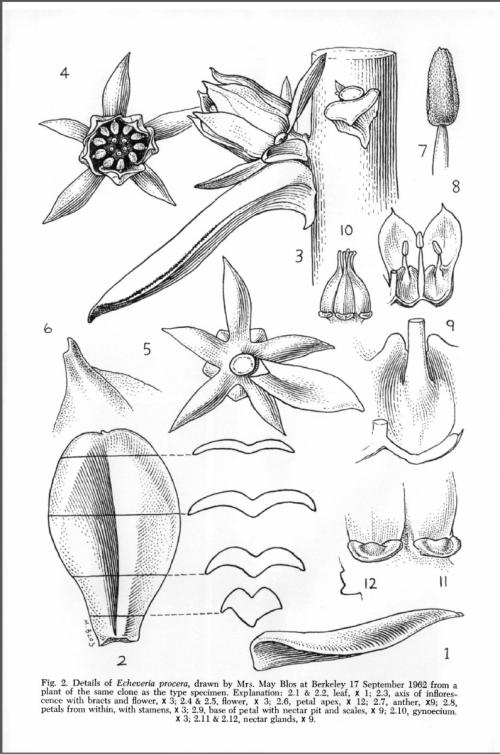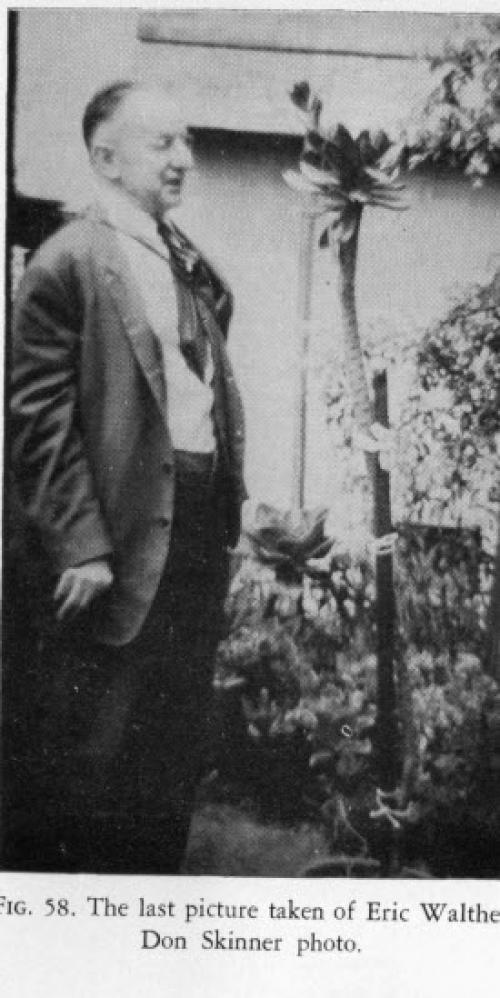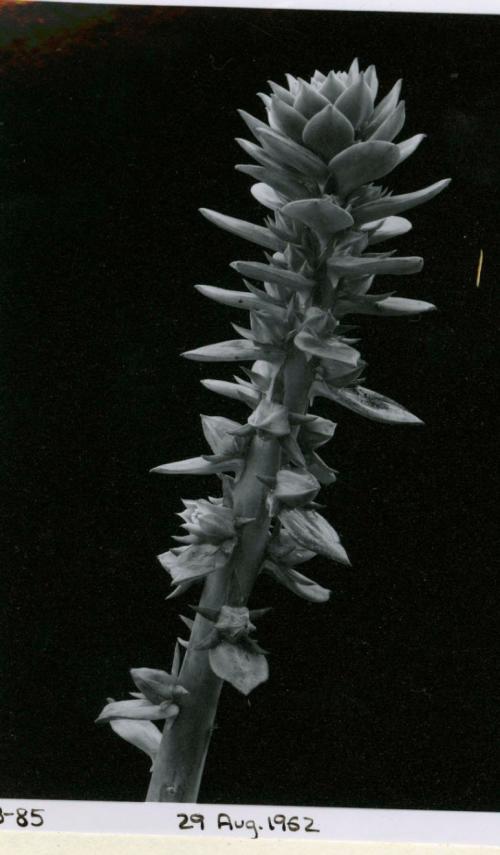PROCERA Moran, 1967 (engl./ fr.)
Series Nudae
Type : MacDougall B-85, La Muralla, about 3300 m, at the summit of Cerro Yucunino, about 10 miles south of Tlaxiaco, Oaxaca, Mexico, 8 January 1947.
Etymology : Latin "procerus" = tall. Named for the growth habit.
Distribution : Mexico (Oaxaca : Only known from the type locality).
Description by Reid Moran in Cactus and Succulent Journal US 39(5): 182-185. 1967 :
Plant glabrous.
Stems erect or in age decumbent, to nearly 2 m tall, 3 - 4 cm thick, sparsely branching, smooth, yellowish green becoming reddish brown and finally gray, the surface at first marked with close-set rhombic leafbase sites 15 - 18 mm wide and 10 - 15 mm high, in 3 and 5 spirals, the attachment scars elliptic, 4 - 6 mm wide, 1 - 2 mm high, tan.
Rosettes 15 - 25 cm wide, of 10 - 30 crowded leaves.
Leaves green or narrowly redmargined, glaucous at first, oblong-obovate, rounded to slightly retuse at the apex, apiculate, 7 - 10 cm long, 4 - 6 cm wide above, ca 13 mm wide at the base, 7 - 10 mm thick at the base, ventrally channeled to a depth of 2 - 4 mm near the middle and shallowly and narrowly near the base, rounded-keeled dorsally, the margins acute, often broadly downcurved.
Floral stems 30 - 110 cm tall, 1 - 1.5 cm thick at the vase, red below, somewhat glaucous, leafy nearly to the base, with ca 40 - 70 leaves but bare by anthesis, stem leaves like the rosette leaves but smaller, to 6 cm long and 3 cm wide.
Inflorescence subspicate, 15 - 40 cm tall, with 30 - 50 or more flowers, bracts horizontal or deflexed, exceeding the flowers, elliptic-obovate, mucronate, spurred, 1.5 - 3 cm long 1 - 1.5 cm wide, 3 - 5 mm thick, the upper clustered rosettelike at the stem apex, pedicels 1.5 - 2 mm long, 2 - 3 mm thick.
Flowers : Calyx green, the desk ca 5 mm wide, the segments widespreading, nearly equal, triangular- lanceolate, subacuminate, 7 - 10 mm long, 2 - 3 mm wide, ca 1 mm thick, corolla near watermelon red without, light yellow within and on covered edges, 11 - 12 mm long, 7 - 8 mm wide at the base, 5 - 7 mm wide at the apex, pentagonal with flattened sides, but the outer petal edges not closely appressed. Petals connate 2 - 3 mm, elliptic, broadly acute, apiculate, 4 - 5 mm wide, dorsally keeled with the flanks concave, ventrally acutely channeled, the nectar pit ca 2.5 - 3 mm long, 2 - 2.5 mm wide, and 1 mm deep, with a distinct scale ca 1 mm long and wide on each side of the stamen base....
Flowers in August and September and apparently sometimes later.
Cytology : n = 22
Link to a summary of the above description in English and French.
Note :
1. E. procera is closely related to E. montana, growing at about the same elevation 65 miles distant. It differs from E. montana in its taller and thicker stems, thicker and more leafy floral stems, smooth and not papillose inflorescence, relatively large bracts, shorter pedicels and more numerous flowers and in having well developed scales on the inner surface of the petals.
2. This species is not in cultivation and according to Reyes, Brachet & González-Zorzano has never been found again since it was first collected in 1947. Its habitat is largely destroyed. (See the description of E. longissima var. brachyantha in Haseltonia 21, Dec. 2015.)
Why nonetheless photos by Reyes & Brachet of E. procera are published here is incomprehensible.
3. Photos on page 40 & 41, figs.287 & 288, of E. procera in Las Crasuláceas de México vol. I, 2003, by Jorge Meyrán García are completely wrong.

Taken from the First Description by R. Moran in Cactus and Succulent Journal US 39(5): 183. 1967.
Note the very long bracts subtending each flower !

Eric Walther admiring E. procera in the collection of Don Skinner.
Photo taken from the cover of CSJ US 31(5), 1952.

Photo taken from the Holotype sheet, showing the extremely big bracteoles sustaining each flower.